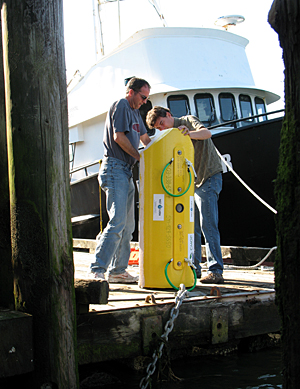You are here
Fostering Partnerships in the Age of Ocean Observatories
12/29/10 Portland, Ore.
Some say oceanography is going through an age of discovery. There are scientists that no longer rely on ship-based methods to study the oceans. They are using observatories to study the biology and chemistry of the oceans on a large scale.
 Partners in Science
Partners in Science
Joe Needoba (on right) and Andrew Barnard work together to deploy a new SATURN observation station.Ocean observatories have the technological advantage of operating autonomously and over long periods of time. This provides the temporal and spatial resolution needed to better understand the ocean. One challenge for scientists is waiting for the latest technologies to become available on the market.
But Joe Needoba, Ph.D. isn’t sitting still. The Center for Coastal Margin Observation & Prediction (CMOP) scientist and his colleagues, António Baptista, Ph.D. and Tawnya Peterson, Ph.D., are partnering with industry to help develop and use the type of instruments that will improve ocean observing.
“Positioning ourselves to be able to do research by partnering with industry is a powerful approach,” Needoba says. “Over the past two years, we have moved in that direction and now have access to the latest technologies for our experiments.”
One of those partnerships is with WET Labs Inc., a leader in developing and manufacturing underwater instrumentation. They are working together on an NSF Rapid Response grant to develop instruments that can specifically detect the aging oil from the Deepwater Horizon oil spill in the Gulf of Mexico. The goal is to use fluorescence to measure the amount of oil in the water column.
“We want to identify the components that dissolve in the water and the molecules that absorb and release light that can be detected by fluorescence,” says Andrew Barnard, Senior Research Scientist, WET Labs. “Working with Joe Needoba will help us identify the optimum operational wavelengths to precisely detect the fluorescent compounds in oil.”
 Sometimes oil and water does mix.
Sometimes oil and water does mix.
A graduate student inspects a sample of crude oil where some components have mixed with water.The CMOP research team will dissolve components of crude oil in water and then detect them with fluorescence spectroscopy. The next step is to degrade those samples and look at how the signal changes over time as if the environment was weathering it. This will provide data on the behavior of the crude oil fluorescence properties in the ocean. The results will supply WET Labs with the information they need to build an instrument that not only identifies the oil but also identifies degraded oil.
Needoba is also partnering with Translume, an advanced glass micromachining company based out of Ann Arbor Michigan. They are working together on a NASA-funded grant to develop a microfluidic device that counts phytoplankton cells in water. But instead of building a large and expensive device, they are developing a small, cost affordable sensor that can be used in situ and relay data directly to a satellite.
NASA uses satellites to observe the earth from space. The instruments look at different aspects of the ocean’s surface including temperature, salinity, current, and phytoplankton. While this works well for the surface water, it doesn’t give a complete picture about the phytoplankton population deeper in the water.
Phytoplankton are an important component of the earth’s system because they utilize carbon dioxide during photosynthesis and therefore help control the amount of carbon dioxide in the atmosphere. If instruments can get an estimate of global phytoplankton populations and where they are located in the ocean, scientists can better relate that to changes in the earth’s climate.
The sensor Translume and Needoba are working on will be installed on an autonomous device like an underwater glider. The glider then will be sent out on an ocean crossing, traveling up and down the water column. The sensor will continuously collect information about the particles located in the water and then relay it, in real time, to the satellite.
“ In phase one, we worked with Joe to identify the specifications for the instrument that would identify and count particles,” says Dr. Thomas Haddock, a Translume scientist. “Now we need to develop and field test the device using CMOP’s SATURN observatory.”
The SATURN observation network is a combination of fixed and mobile assets that extend across the Columbia River estuary, plume and shelf. Needoba and the CMOP research team will develop several prototypes and field test the devices on SATURN-03, a platform located in the Columbia River estuary. This part of the project will demonstrate the usefulness of the instrument in the field.
These kinds of partnerships will continue to be a win-win situation for both research and industry. Companies gain the knowledge of scientific experts, like Needoba, to identify the issues most in need of new product development. Research labs benefit from having access to engineers that will build tools they can use for experiments. With both working together to solve environmental problems, the age of discovery in ocean observing will continue to move forward.
Written by Jeff Schilling
##
About The Center for Coastal Margin Observation & Prediction
The Center for Coastal Margin Observation & Prediction (CMOP) is a National Science Foundation Science and Technology Center. CMOP is creating a new paradigm for conducting coastal-margin science. It is anticipatory rather than reactive, and is based on the emerging power of structured integrations of information, methods and people. The center is a collaborative effort of many academic and industry partners, lead by Oregon Health & Science University (host institution), Oregon State University, and University of Washington.






